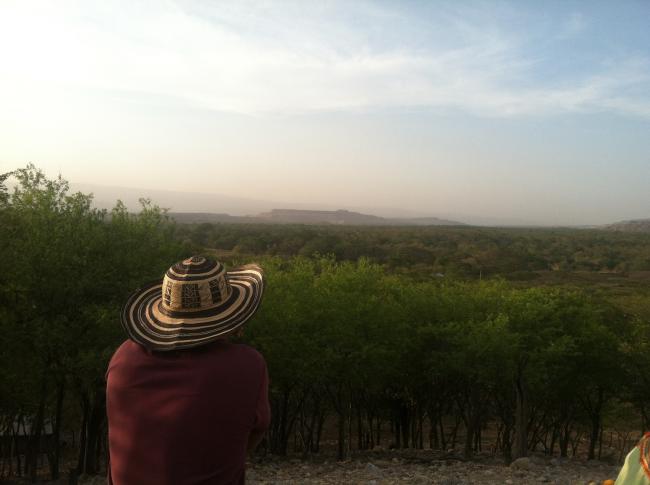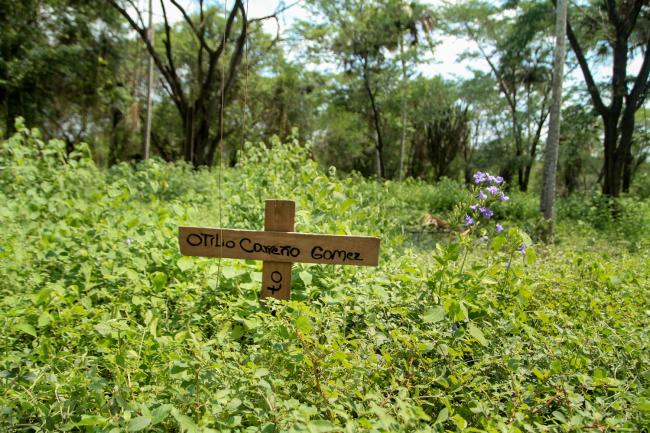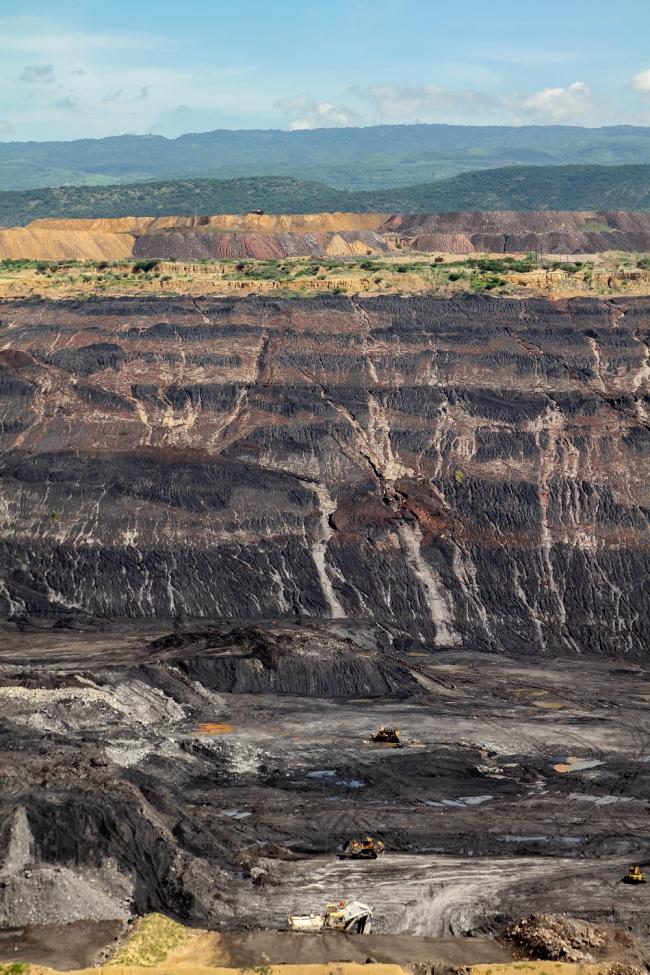
Colombia has the largest number of internally displaced persons (IDPs) in the world. An estimated 6.9 million people have been forced from their homes because of the armed conflict between right-wing paramilitaries, left-wing guerillas, and the government over control of land, political power, and the economy. The peace accords between the FARC guerillas and the government over the conditions of the end of the armed conflict include measures for returning land to displaced people and compensating victims of violence, strengthening the already existing 2011 Victims and Land Restitution Law. Both the FARC and the government recognize that to ensure peace, Colombia must resolve longstanding land and resource conflicts, and incorporate its most marginalized people into state institutions. Yet, these guidelines leave out another vulnerable population: the thousands of people displaced by natural resource extraction and megaprojects each year.
Unlike Colombia’s official IDPs— defined as people who are displaced by threats or violence by paramilitary of guerilla groups within their own countries— the state does not recognize people displaced by mining. In Colombia, it is legal to expropriate communities in a zone designated for natural resource extraction or megaprojects. If an individual or family does not reach an agreement for selling their land to the corporation or agency that owns the concession rights, the company can file an expropriation order. The Colombian state upholds the rights to these concessions, often sending in the military or police to enforce an expropriation order.
Since 2013, I have worked with communities in the department La Guajira who have been displaced by the Cerrejón mine— the world’s largest open pit coal min. Rogelio Ustate Arrogoces, a leader from the displaced community of Tabaco and a national representative of Afro-Colombians displaced by mining, is fighting for state recognition for victims of this form of displacement. In his piece on victims of mining-based displacement, he writes, “We demand that society and the Colombian state recognize forced displacement resulting from mining as a humanitarian tragedy that destabilizes all aspects of our lives, forcing persecuted people to change the rhythm of their lives and become victims of social rejection.”
Ustate is from La Guajira, a frontier region in the Northeast that shares a porous border with Venezuela. Until the arrival of natural resource extraction projects to the region, La Guajira was a refuge for marginalized people seeking land and autonomy. The Wayuu people indigenous to La Guajira have long prided themselves on maintaining their culture, language, and social organization during colonization, and for keeping the modern Colombian state at arm’s length. Similarly, Afro-Colombians in the region are primarily descendants of freed and escaped slaves who founded autonomous settlements and developed unique traditions that are a hybrid of mestizo, African, and indigenous culture.
However, over the last thirty years, the Colombian government has broken up indigenous and afro-descendent territories, the majority of which are tierras baldías (untitled, state-held lands), into natural resource concessions, for sale to the highest bidder. Most people who live in these territories do not hold individual land titles, which means they cannot prove how many acres they actively farm or use. The Cerrejón coal company, which is jointly owned by BHP Billiton, Glencore Xstrata, and Anglo American, has compensated individuals for the loss of their houses, animals, and crops, but does not have to pay rural people for all of the land they use for cultivation or grazing. Furthermore, much of the land has traditionally been held communally for hunting, fishing, and gathering medicinal plants. When the mine moved in, people lost access to these communal lands and thus to their means of providing for their families.
On August 9, 2001, in Ustate’s hometown of Tabaco, Colombian rural police forces participated in the forced removal of some 420 families, since that land was part of Cerrejón’s active concession zone. Although the people of Tabaco knew they would eventually have to move since they lived on top of a coal reserve, they had no prior warning of the August 9 deadline. Within a matter of hours, police and private security forces used riot gear and tear gas to remove people and their animals from the territory. They bulldozed residents’ houses, barns, corrals, and the local school as horrified residents looked on, leaving Tabaco in ruins.
The physical act of displacing people has often led to egregious human rights violations, yet the Colombian government does not investigate these incidents nor enforce compensation for those displaced by legal expropriation. In February of this year, the Escuadrón Móvil Antidisturbios (Mobile Anti-Disturbance Squad, ESMAD), the police squad used for riots and protests, expropriated the last families living in Roche, another Afro-Colombian community living in Cerrejón’s concession zone. Community members filed a formal complaint for the unnecessary use of force, but thus far have not received a satisfactory response from state human rights offices.

The trauma and loss felt in Tabaco motivated Ustate to become a grassroots and now national-level leader to fight for a better future for his community and Colombia. Since becoming a displaced person, he has witnessed the cooptation of leaders, the rupture of local social fabric, division of the communities, and threats through intimidating phone calls. (Although the source of these threats is unknown, many suspect that they come from neo-paramilitary groups). “Today, this bloody and fiery uprooting by mining is the everyday face, the harshest symbol of the tragic reality of ethnic peoples,” Ustate writes. “It is impossible not to recognize the magnitude of the human drama which we ethnic communities endure, under which hundreds of thousands of families have had to leave their lands, their homes, their community, their whole lives, only to be launched into precarious and foreign world.”
Land conflict and restitution
Although unlike victims of the armed conflict, victims of mining or megaproject displacement have no legal recognition or rights to land restitution under current Colombian legislation, they suffer many of the same social problems as IDPs. These include socioeconomic instability, increased exposure to and participation in criminal gangs, forced urbanization, discrimination, psychological trauma, and loss of cultural values.
Ustate has witnessed these problems firsthand, having lived as a displaced person for 15 years. “Human rights violations and violence have caused multiple traumas, forever marking the displaced community for the rest of their lives. In addition, arriving in an unknown place generates high risks and uncertainties due to the difficulties of finding an adequate source of income and a place to live, leaving these communities at elevated risk for turning to begging, prostitution, and delinquency,” he writes. This is all caused by drastic changes in their way of life, because of the loss of family incomes that eats away day by day at La Guajira’s territory.”
Ustate describes how displacement has impacted indigenous and Afro-Colombian peoples’ abilities to continue their cultural practices and traditional ways of life. “We have been forced into an unknown world, leaving behind our culture and our beliefs, or simply ‘forgetting’— we have been silenced and denied the historical memory of these crimes against humanity.”
In La Guajira, both Wayuu and Afro-Colombians displaced by Cerrejón have become more vulnerable to violence as they lose their lands, social organization, and cultural practices that hold communities together. In some cases, these communities have been victimized by guerilla or paramilitary groups. Nuevo Espinal, a Wayuu community in La Guajira has suffered trauma at the hands of these groups. The state-run Carbacol company, which held 50 % of the Cerrejón mine until 2001, relocated Nuevo Espinal in 1994 in order to mine coal under the community’s lands. While the government gave the community a 400-hectare land plot to build a new home, the state never gave Nuevo Espinal a collective title to the land nor formally recognized it as an indigenous community entitled to special protections under the 1991 Constitution. Furthermore, the land granted to Nuevo Espinal, which lies very close to the Venezuelan border, is a key smuggling route for contraband, which placed the community in the middle of a turf war between the AUC paramilitaries and FARC guerillas. These groups have assassinated three community members and threatened many more, according to the official declaration approved by the Colombian state’s Victims Unit. As a result, many of the families have abandoned their homes and will not return until the state guarantees their safety.

Nuevo Espinal is currently in the process of gaining legal protections from the state as a collective victim of the armed conflict and for land restitution under the 2011 Victims and Land Restitution Law. While their fight for recognition has lasted much longer than it should – a common theme among victims claiming reparations – this legal recognition is the first step to the community rebuilding itself through formalizing their territory and gaining economic and social benefits. Nuevo Espinal residents are holding the state accountable for their original displacement and for the secondary impacts of this displacement through the Victims’ Unit and Land Restitution Unit. These cases demonstrate that legal displacement and illegal displacement often go hand-in-hand. Many rural communities have been victims of both corporate-driven displacement and conflict-driven violence.
As Colombia prepares for peace, it must grapple with the uneven distribution of wealth, land, and social power that has driven the protracted armed conflict. Conflicts between corporations and rural communities over land and environmental damage have already provoked violence in Colombia. Between 2001 and 2011, there were at least 277 conflicts in natural resource extraction zones – the number increasing steadily after 2008. These social conflicts threaten the post-conflict agenda by increasing incentives for mass protest, and for disenfranchised people to support or work for guerillas, paramilitaries, and BACRIM neo-paramilitary and criminal gangs who offer employment and protection.
In the post-conflict scenario, conflicts over natural resource extraction and mega projects are likely to grow. By encouraging foreign investment in natural resource extraction and infrastructure, Colombia’s dominant political and economic model threatens the already marginalized populations who live in natural resource frontiers. Without accommodating these rural populations, social and political struggles will continue, which will impede the implementation of the peace accords and prevent state institutions form regaining civil society’s trust. Applying a similar legal framework for protections, compensation and land restitution for IDPs (as well as improving the process of guaranteeing IDPs rights) to people displaced by natural resource extraction, as well as formally regulating and preventing future displacement should be part of Colombia’s post-conflict agenda.
When the FARC and the Colombian government signed a ceasefire agreement on June 23 of this year, many Colombians celebrated this historical moment. Yet, for people living in Colombia’s frontiers and borderlands, the meaning of peace is ambiguous. The Colombian state has been preparing for the post-conflict moment for years both through passing new laws to protect victims and negotiating a peace accord with the FARC. However, in frontier regions, the institutional state has historically remained at a distance.
In some zones, such as Putumayo, the FARC has long filled the power vacuum left by the state; it is the FARC who has kept social order, run local elections, enforced security regimes, provided employment, and run development and infrastructure projects. In natural resource frontiers, corporations often play the role of a pseudo-state. In La Guajira, the Cerrejón coalmine has taken on state-like responsibilities for security, schools, and infrastructure. Increasingly, La Guajira communities have begun to protest the negligence and compliance of the Colombian government in allowing corporations to implement the rule of law, seize territories, and transform the socioeconomic relations of power. On August 18, 3,000 people marched in the streets of the capital of Riohacha against the Santos government’s economic policies and plan to hold a civic strike in September to demand an alternative to the extractivist model that has left the region in crisis.
We can learn many lessons from those in La Guajira on the importance of protecting communal land rights, cultural traditions, social organization, and above all basic human dignity. The national pushback against the neo-extractivist model is widespread; opposition appears through national protests, Constitutional Court decisions, and grassroots resistance movements. It is time the Santos administration re-evaluated the long-term risks of a political-economic model, which enforces rather than resolves the unequal relations of power that have driven the protracted conflict. Rather than inviting the private sector to support the peace process through economic incentives, it is time to better regulate corporate access to land and natural resources. It is time to question the ethics and long-term consequences of displacing people for economic benefits. Rural communities displaced by mining are victims of the neo-extractivist model. They too deserve compensation for their suffering and incorporation into the post-conflict agenda.
Read more of Rogelio Ustate Arrogoce’s comments in Spanish here.
Emma Banks is a PhD candidate in anthropology at Vanderbilt University. Her research and activism focuses on the displacement and resettlement of Wayuu and Afro-Descendant communities by the Cerrejón open pit coal mine.

